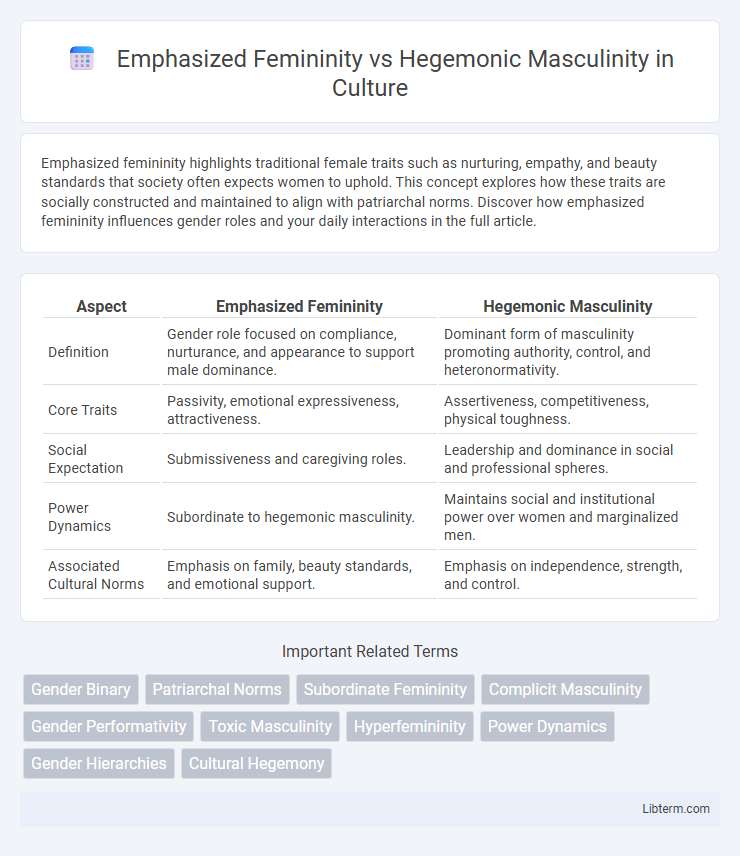Emphasized femininity highlights traditional female traits such as nurturing, empathy, and beauty standards that society often expects women to uphold. This concept explores how these traits are socially constructed and maintained to align with patriarchal norms. Discover how emphasized femininity influences gender roles and your daily interactions in the full article.
Table of Comparison
| Aspect | Emphasized Femininity | Hegemonic Masculinity |
|---|---|---|
| Definition | Gender role focused on compliance, nurturance, and appearance to support male dominance. | Dominant form of masculinity promoting authority, control, and heteronormativity. |
| Core Traits | Passivity, emotional expressiveness, attractiveness. | Assertiveness, competitiveness, physical toughness. |
| Social Expectation | Submissiveness and caregiving roles. | Leadership and dominance in social and professional spheres. |
| Power Dynamics | Subordinate to hegemonic masculinity. | Maintains social and institutional power over women and marginalized men. |
| Associated Cultural Norms | Emphasis on family, beauty standards, and emotional support. | Emphasis on independence, strength, and control. |
Understanding Emphasized Femininity
Emphasized femininity refers to a cultural ideal that promotes compliance, nurturance, and sexual receptivity as key traits for women within a patriarchal society. This concept highlights how femininity is constructed around accommodating male dominance and prioritizing relational and aesthetic qualities to maintain gender hierarchies. Understanding emphasized femininity involves analyzing gender roles that enforce women's subordination while reinforcing hegemonic masculinity through contrasting behavioral expectations.
Defining Hegemonic Masculinity
Hegemonic masculinity refers to the culturally dominant ideal of male behavior, emphasizing traits such as authority, physical strength, and heterosexuality, which maintain men's social dominance over women and other gender identities. This concept highlights how certain masculine norms are socially constructed to legitimize male dominance and marginalize alternative masculinities. Understanding hegemonic masculinity is crucial in analyzing gender power relations and the reinforcement of patriarchal structures in society.
Historical Contexts of Gender Roles
Emphasized femininity and hegemonic masculinity have evolved from distinct historical contexts where gender roles were rigidly defined by patriarchal structures, reinforcing male dominance and female subordination. Emphasized femininity historically aligned with traits like passivity, nurturance, and compliance, serving to uphold traditional family and social hierarchies, while hegemonic masculinity embodied authority, competitiveness, and control, legitimizing male power in political and economic spheres. These gender constructs were deeply embedded in cultural norms and legal frameworks, shaping social expectations and limiting opportunities for gender equality across different historical periods.
Power Dynamics in Gender Relations
Emphasized femininity aligns with compliance to patriarchal norms by valuing traits like nurturance and passivity, reinforcing male dominance in gender relations. Hegemonic masculinity asserts power through dominance, authority, and control, shaping societal expectations that legitimize male privilege. These power dynamics maintain hierarchical gender structures where masculinity is normalized as superior while femininity is marginalized as subordinate.
Media Representations of Femininity and Masculinity
Media representations of femininity often emphasize Emphasized Femininity, portraying women as nurturing, passive, and appearance-focused to reinforce traditional gender roles. In contrast, hegemonic masculinity in media highlights traits such as dominance, aggression, and emotional restraint, establishing an idealized male identity that sustains patriarchal power structures. These portrayals contribute to societal expectations by perpetuating gender binaries and limiting the diversity of expressions for both femininity and masculinity.
Socialization and Gender Expectations
Emphasized femininity, rooted in socialization, promotes traits like nurturing, passivity, and appearance-focused behavior as ideal for women, reinforcing traditional gender expectations. Hegemonic masculinity upholds dominance, assertiveness, and emotional restraint as standards for men, shaping male social roles and power dynamics. These contrasting gender norms are perpetuated through family, media, and education, solidifying societal expectations and limiting individual gender expression.
The Impact on Identity Development
Emphasized femininity promotes identity development through compliance with traditional gender roles that prioritize nurturing, passivity, and appearance, shaping women's self-concept around societal expectations of caregiving and relational dependency. In contrast, hegemonic masculinity fosters identity by valuing dominance, toughness, and emotional restraint, encouraging men to develop a self-image tied to power, control, and autonomy. These conflicting gender ideals significantly influence psychological growth and social behavior, often resulting in constrained expressions of identity aligned with rigid masculine and feminine norms.
Intersectionality in Gender Ideals
Emphasized femininity and hegemonic masculinity represent socially constructed gender ideals that intersect with factors such as race, class, and sexuality, shaping diverse experiences of identity and power. Intersectionality reveals how emphasized femininity often relies on compliance with patriarchal norms, disproportionately affecting women of marginalized backgrounds. Hegemonic masculinity upholds dominance through traits linked to authority and control, but its expression varies significantly across different social and cultural contexts.
Challenging and Resisting Gender Norms
Emphasized femininity, characterized by compliance with patriarchal expectations, often contests hegemonic masculinity by highlighting the power dynamics embedded in traditional gender roles. Challenging these norms involves both women and men actively resisting societal scripts that dictate emotional expression, dominance, and submissiveness, promoting a more inclusive understanding of gender identity. Such resistance fosters social spaces where non-conforming identities thrive, undermining the legitimacy of hegemonic masculinity as the dominant gender framework.
Toward Gender Equality: Rethinking Femininity and Masculinity
Emphasized femininity and hegemonic masculinity represent socially constructed gender norms that reinforce traditional power dynamics, with emphasized femininity aligning with compliance and subordination, while hegemonic masculinity upholds dominance and authority. Rethinking these concepts is crucial for advancing gender equality by challenging rigid stereotypes and promoting diverse expressions of femininity and masculinity that support equity and inclusion. This shift encourages dismantling hierarchical gender relations and fostering identities that embrace vulnerability, cooperation, and respect across all genders.
Emphasized Femininity Infographic

 libterm.com
libterm.com